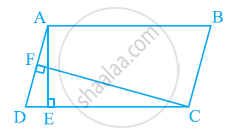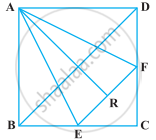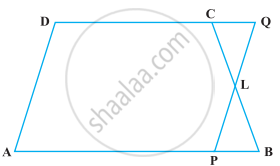Advertisements
Advertisements
Question
The diagonals of a parallelogram ABCD intersect at a point O. Through O, a line is drawn to intersect AD at P and BC at Q. Show that PQ divides the parallelogram into two parts of equal area.
Solution
Given: In a parallelogram ABCD, diagonals intersect at O and draw a line PQ, which intersects AD and BC.
To prove: PQ divides the parallelogram ABCD into two parts of equal area.
i.e., ar (ABQP) = ar (CDPQ)
Proof: We know that, diagonals of a parallelogram bisect each other.
∴ OA = OC and OB = OD ...(i)
In ΔAOB and ΔCOD,
OA = OC
OB = OD ...[From equation (i)]
And ∠AOB = ∠COD ...[Vertically opposite angles]
∴ ΔAOB = ΔCOD ...[By SAS congruence rule]
Then, ar (ΔAOB) = ar (ΔCOD) ...(ii) [Since, congruent figures have equal area]
Now, in ΔAOP and ΔCOQ,
∠PAO = ∠OCQ ...[Alternate interior angles]
OA = OC ...[From equation (i)]
And ∠AOP = ∠COQ ...[Vertically opposite angles]
∴ ΔAOP ≅ ΔCOQ ...[By ASA congruence rule]
∴ ar (ΔAOP) = ar (ΔCOQ) ...(iii) [Since, congruent figures have equal area]
Similarly, ar (ΔPOD) = ar (ΔBOQ) ...(iv)
Now, ar (ABQP) = ar (ΔCOQ) + ar (ΔCOD) + ar (ΔPOD)
= ar (ΔAOP) + ar (ΔAOB) + ar (ΔBOQ) ...[From equations (ii), (iii) and (iv)]
⇒ ar (ABQP) = ar (CDPQ)
Hence proved.
APPEARS IN
RELATED QUESTIONS
In the given figure, ABCD is parallelogram, AE ⊥ DC and CF ⊥ AD. If AB = 16 cm, AE = 8 cm and CF = 10 cm, find AD.

P and Q are any two points lying on the sides DC and AD respectively of a parallelogram ABCD. Show that ar (APB) = ar (BQC).
A farmer was having a field in the form of a parallelogram PQRS. She took any point A on RS and joined it to points P and Q. In how many parts the field is divided? What are the shapes of these parts? The farmer wants to sow wheat and pulses in equal portions of the field separately. How should she do it?
Parallelogram ABCD and rectangle ABEF are on the same base AB and have equal areas. Show that the perimeter of the parallelogram is greater than that of the rectangle.
In the following figure, ABCD is parallelogram and BC is produced to a point Q such that AD = CQ. If AQ intersect DC at P, show that
ar (BPC) = ar (DPQ).
[Hint: Join AC.]

PQRS is a rectangle inscribed in a quadrant of a circle of radius 13 cm. A is any point on PQ. If PS = 5 cm, then ar (PAS) = 30 cm2.
ABCD is a square. E and F are respectively the mid-points of BC and CD. If R is the mid-point of EF (Figure), prove that ar (AER) = ar (AFR)

In trapezium ABCD, AB || DC and L is the mid-point of BC. Through L, a line PQ || AD has been drawn which meets AB in P and DC produced in Q (Figure). Prove that ar (ABCD) = ar (APQD)

ABCD is a trapezium in which AB || DC, DC = 30 cm and AB = 50 cm. If X and Y are, respectively the mid-points of AD and BC, prove that ar (DCYX) = `7/9` ar (XYBA)
In the following figure, ABCD and AEFD are two parallelograms. Prove that ar (PEA) = ar (QFD). [Hint: Join PD].

